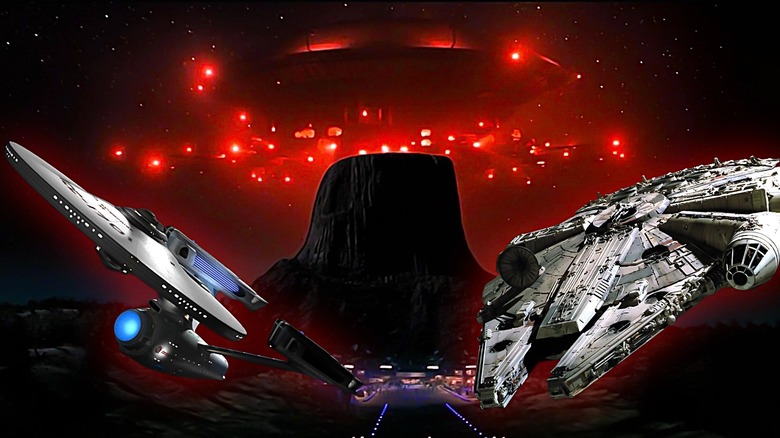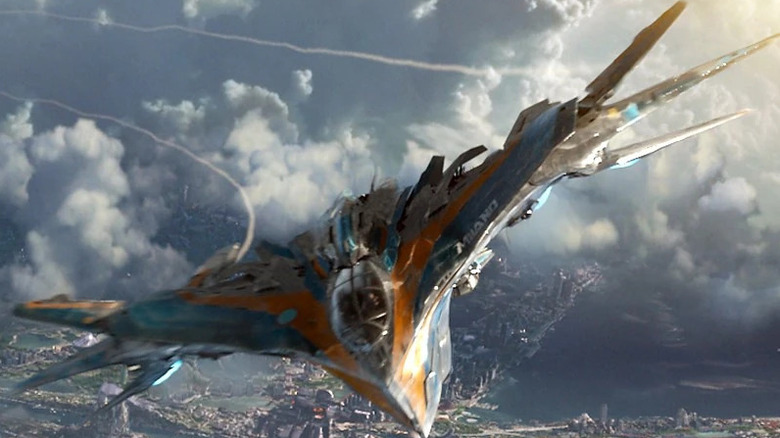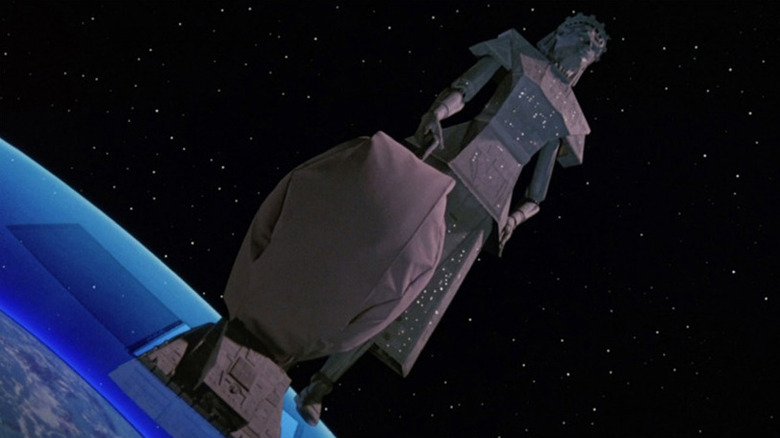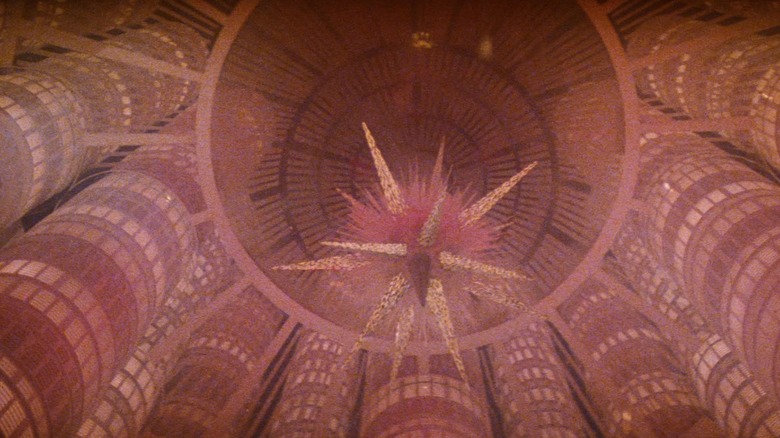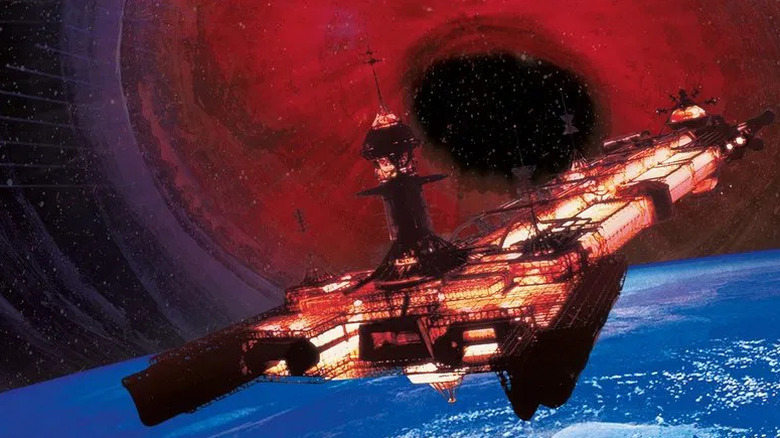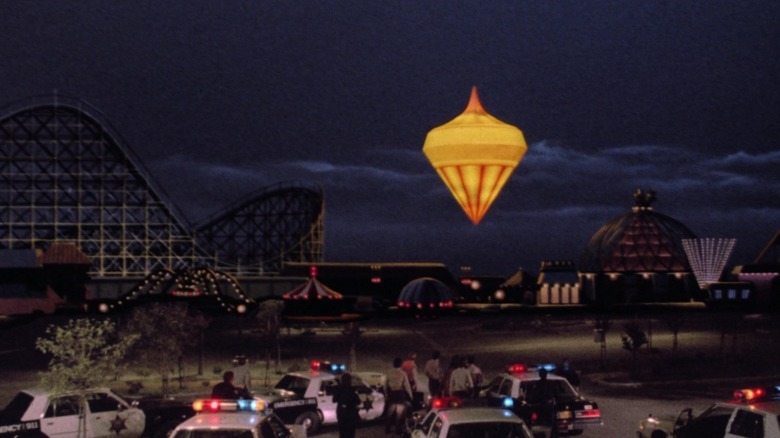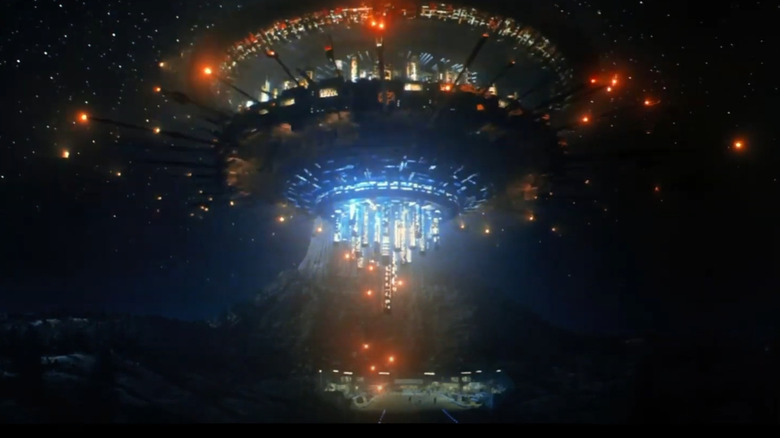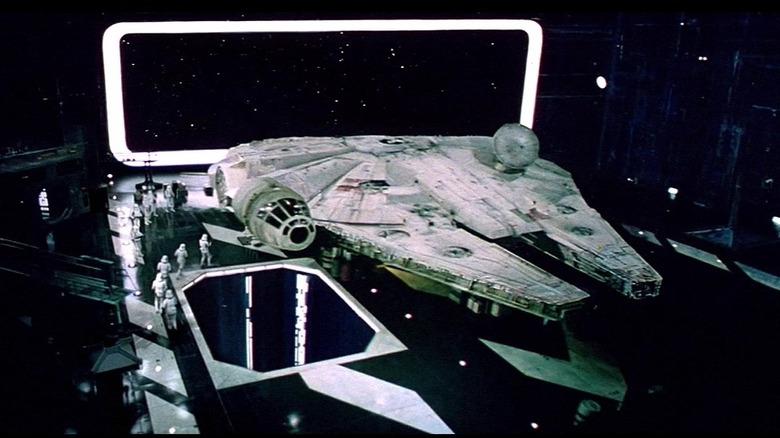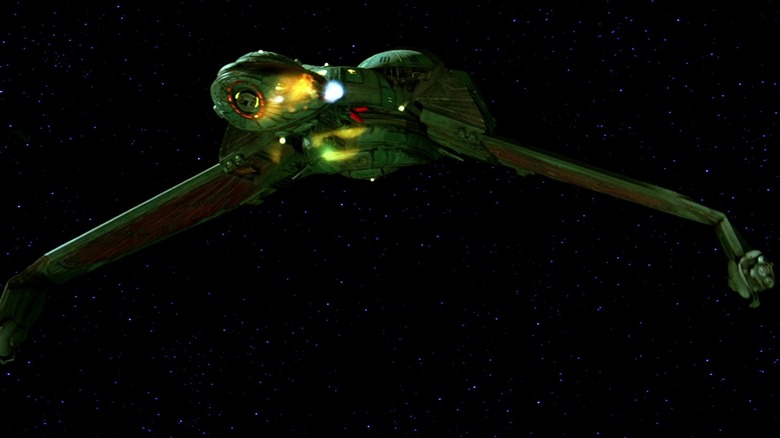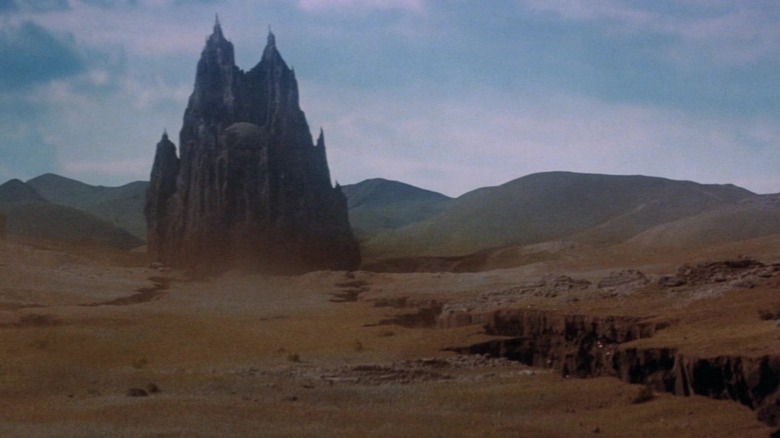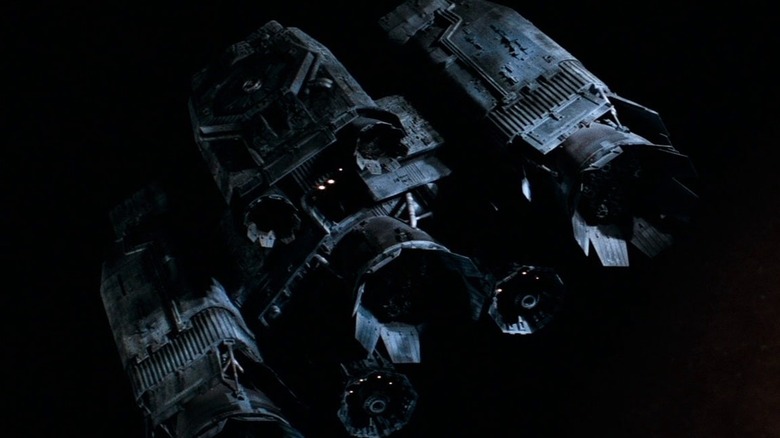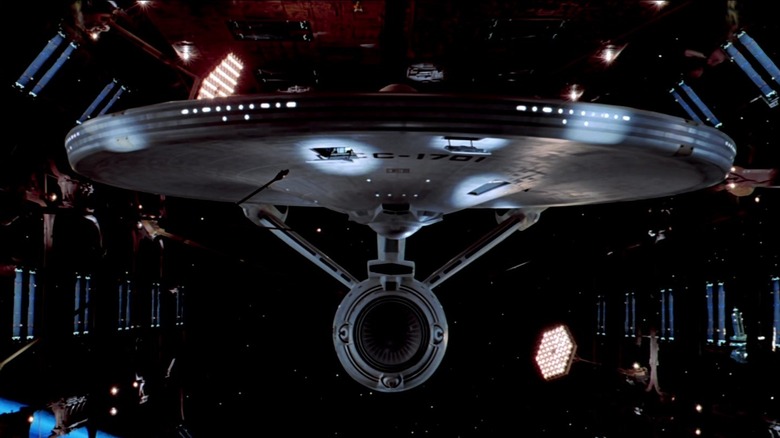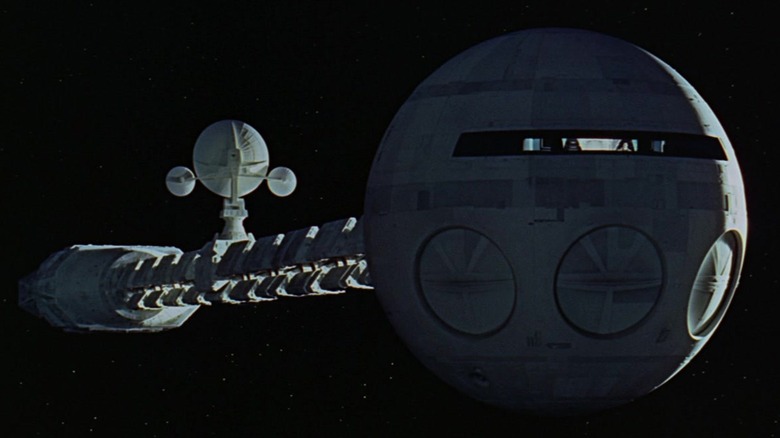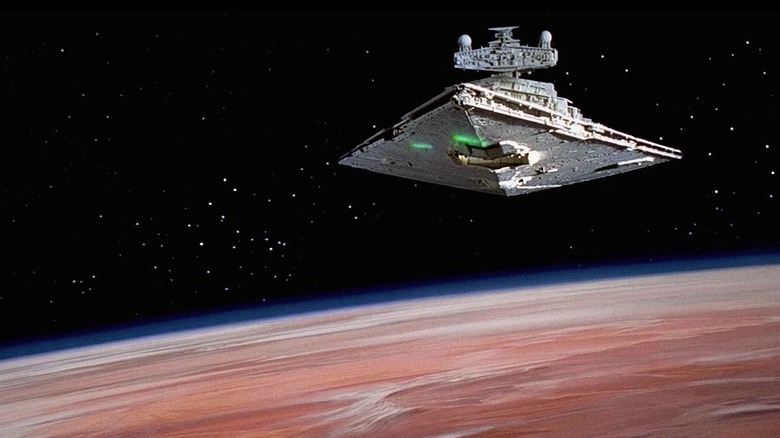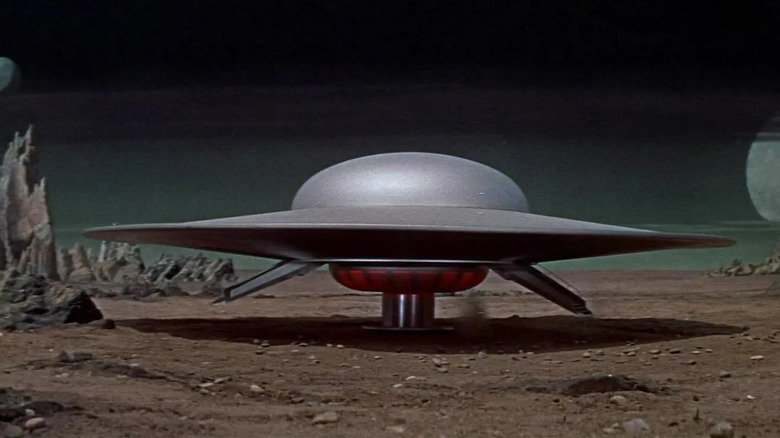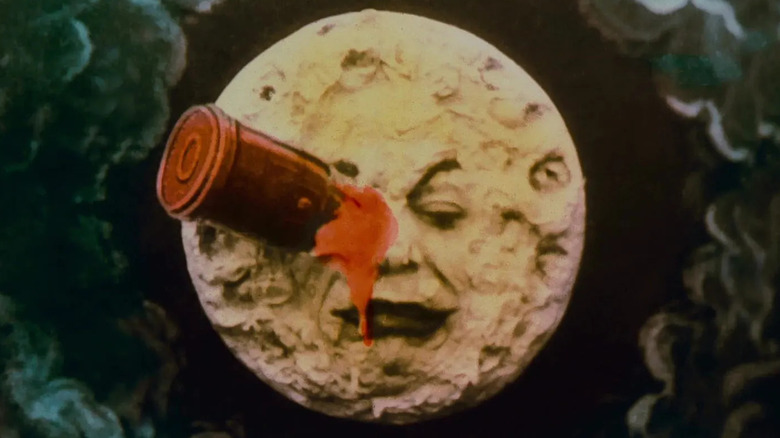The 15 Best Movie Spaceships Of All Time, Ranked
Space. The final frontier. Cinematically traversed by the coolest vehicles ever made. Movie spaceships, frankly, rule. They get into amazing situations, they make for awesome toys, and because they aren't actually real, they can look as cool or ridiculous as their creators want or need them to, reality be damned. The only limit is human imagination.
In real life, on our planet, spaceships are strictly limited in how far they can take humans, and are generally used mainly for exploration and science. On the big screen, some may prioritize exploration, but many also serve as conduits for planetary invasion, or fighters against such things. Some look silly to our eyes now, while others might be deceptively junky.
To make our best list, the rule is that they must have at least one distinct pilot (sorry Unicron; you're a robot, however awesomely voiced), and if they're based on anything pre-existing, have to have unique aspects in their onscreen iteration (alas, Peter Cushing's cinematic TARDIS, you're not different enough from the "Doctor Who" TV version in your day). They might carry heroes, villains, weird aliens, or anything and anybody in between, but by our calculations, these are the best movie spaceships of all time.
15. The Milano (Guardians of the Galaxy)
Like its owner, Peter Quill, who goes from carefree spacefarer to head of a de facto family, the Milano evolves from a space bachelor pad to an admittedly cramped single-family home over the course of the "Guardians of the Galaxy" saga. Fans of Marvel's cosmic comic books had some doubts about whether or not the brightly colored universe on the page could translate to the big screen for an audience accustomed to "Star Wars" and mostly gray spaceships, but director James Gunn rose to the challenge. George Lucas, for all his love of race cars, never painted his spaceships quite like this, nor gave them as many wings at once. Ironically, the colors of the Milano are those of a car — the one driven by Quill's father, Ego, when he comes to Earth in human form to make a baby, solidifying the bachelordom-to-family theme.
Ultimately, the team has to trade up for a newer model, but you never forget your first. Named after Quill's remembered childhood crush, actress Alyssa, the Milano is what made him Star-Lord and an Avenger ... even if it was only the beginning of a legend.
14. Spaceball One/Mega-Maid (Spaceballs)
Decades before Michael Bay brought Optimus Prime to the big screen in live-action, Mel Brooks gave us a traditionally modeled, non-CG, unofficial Transformer in 1987's "Spaceballs." He almost certainly cheated on the transformation, but it's an absurd comedy, and it doesn't matter, as the scene sufficiently sells the joke.
When first we see Spaceball One, it's a sight gag unto itself, as it just keeps going, on and on, a ridiculously long spaceship revealing its size as the ominous musical cue repeats itself to the point of absurdity, until finally a bumper sticker is revealed on the back. It reads, "We brake for nobody."
When the mega-ship finally approaches its mission of terror to steal the atmosphere of planet Druidia, it begins shape-shifting, moving parts around, and becoming a giant robot maid with the galaxy's biggest (and most easily reversible) vacuum cleaner. The head may look familiar-ish with its Statue of Liberty silhouette; that's by design, so the movie can sandwich in a "Planet of the Apes" parody after the big ship explodes. It's versatile for laughs, but the model is also as detailed as any built by Lucasfilm, which makes Spaceball One not just a classic of comedy, but a pretty cool spaceship in itself, even before it does anything. It inspired one of several fan-proposed LEGO ideas.
13. Krypton Escape Ship (Superman: The Movie)
In vintage Superman comic books, the rocketship that brought baby Kal-El from an exploding Krypton to Earth looked like a pretty standard sci-fi rocket, albeit in bright colors. Back when the idea of a serious superhero movie was a new thing, however, director Richard Donner went for a more realistic take on Earth, and a more alien aesthetic for Krypton. Thankfully, he left the tights and cape alone — a principle that producer Jon Peters would later try to ignore at his peril.
1970s movie Krypton is a society based on crystals and glowing white surfaces and clothes. It's arguably a disco-inspired aesthetic, and the escape ship for infant Superman looks like a chandelier, or possibly an everlasting gobstopper. As the Mad Magazine parody at the time noted, they could have aimed the ship towards the ceiling of Radio City Music Hall and it would have fit right in. Not only does the ship have visual style, however, but also functionality, giving a newborn infant all the education he needs to learn how to stand up and walk, despite him having room to do neither inside the vehicle.
12. The USS Cygnus (The Black Hole)
Loosely inspired by "20,000 Leagues Under the Sea," Disney's "The Black Hole" depicts a mad, driven genius aboard a unique vehicle on a terrifying quest. Unlike the Nautilus, however, which was an aggressive sinker of ships, the U.S.S. Cygnus is more like a haunted house, or cathedral, in space. It mostly hovers with the lights off, and when they do turn on, they're like a hellish internal flame. Inside, silent sentry robots and zombified cyborgs quietly control the long corridors, vast greenhouses, and other areas of the creepy vehicle that has become the personal fiefdom of Hans Reinhardt (Maximillian Schell). As the movie begins, he lures in the crew of the nearby, smaller Palomino, and plans never to let them leave.
"The Black Hole" is unusually dark for Disney, infamously ending with every surviving character sucked into a black hole, and Reinhardt himself going directly to a literal Hell. Still, it's the Cygnus itself that really sets the dark tone. Like Charon's mythical ferry across the river Styx in Greek mythology, it's a conduit to nowhere good, and every inch of it, inside and out, reminds you of that fact constantly.
11. The Big Top (Killer Klowns From Outer Space)
According to the mythology proposed by "Killer Klowns From Outer Space," the eighth-best scary clown movie of all time, all our earthly notions of clowns and circus tents have alien origins. These candy-colored grotesques reproduce using popcorn, cocoon human captives in deadly cotton candy, and die when shot in the nose. Anyone who has ever been afraid of mimes or shadow puppets might just be recalling a genetic memory of ancestors encountering these fiends and their supernatural powers. Most elaborate of all is their spaceship, which spins like a top, buries itself deeply enough in the ground to look like a tent, and contains all manner of cartoonishly colorful devices within.
Obviously, it's best not to take this particular movie too seriously, but the amount of thought that filmmakers and makeup creators, the Chiodo brothers, put into rendering this deliberately ridiculous reality definitely shows. As another alien might point out, a spinning tent may not be logical, but the fact that it's controlled by a Kong-sized Klownzilla just takes the (funnel) cake.
10. The Mothership (Close Encounters of the Third Kind)
It might look like a flying saucer from directly above or below, but it's much more intricate than that. Full of strands and protrusions, the Mothership from "Close Encounters of the Third Kind" is like a gigantic jellyfish-shaped Christmas tree ornament, although director Steven Spielberg was inspired by the lights of an oil refinery at night. It also functions as a giant synthesizer, communicating musically — at least, after sending Richard Dreyfuss' Roy Neary, and others, enough psychic advance messages to make their families despair.
Conveniently suited to landing on Devil's Tower in Wyoming, this Mothership comes in peace, designed more for awe than shock. Audiences have been divided over the years as to whether or not alternate cuts of the movie show too much of the interior, but from the outside, this spaceship is a thing of wonder. Just don't start sculpting it from your mashed potatoes.
9. The Millennium Falcon (Star Wars)
Perhaps the all-time greatest twist on the flying saucer, or the dirty dish, is the Millennium Falcon. Adding extra protruding bits makes all the difference, and helps it resemble a lucky horseshoe, but this iconic ship could easily have looked very different. A prior design, which had to be changed, was originally more tube-shaped, making it look too similar to the Eagles of "Space: 1999."
The ship that made the Kessel Run in less than 12 parsecs, yet has a hyperdrive that constantly breaks down, always finds itself in a vital position to save the "Star Wars" universe, whether in the hands of Han Solo, Lando Calrissian, or Rey Skywalker. Rooted in George Lucas' love of custom hot rods, the Millennium Falcon is designed as a freighter but customized by a smuggler and Imperial-trained pilot.
The fastest hunk of junk in the galaxy pointedly looks the part, especially when compared to its cleaner look under Lando, but as we know, she's got it where it counts. Able to sneak up on Darth Vader, hide from a Star Destroyer, and even fly through a crystalline planet with a bunch of Porgs on board, it's stealthy and utilitarian. Yet it can also pack a big punch, as seen at the destruction of the second Death Star.
8. Klingon Bird of Prey, B'rei Class (Star Trek III: The Search for Spock)
While the first two "Star Trek" movies mostly stuck to upgrading the detail on pre-existing ship designs, the third brought us the most badass new ship design to that point: The Klingon Bird of Prey. Intended in the original script to be Romulan, like the classic series vehicle with feathers painted on the outside, it changed to Klingon without breaking canon too badly, since the Klingons and Romulans had once had an alliance of shared technology.
Director Leonard Nimoy came up with the neck and the bird-like wings with red undersides that more subtly suggested feathers. The gun wings make it just look more aggressive than the usual Trek ship, and the cloaking device gives it a bonus edge against enemies. Captured from Captain Kruge, redubbed the "H.M.S. Bounty" by Kirk and crew, and eventually revisited in "Picard" season 3, the first B'rei Class Bird could even travel backwards and forwards in time with the right slingshot orbit around the sun — and carry whales with the addition of transparent aluminum (which has since become a real thing).
7. The Black Fortress (Krull)
The enemy stronghold from the movie — and planet — "Krull" is a mountain that travels through space, and resembles a hardened citadel when it plants itself down on a planet's surface. Plus, it dematerializes every two days and shows up in a new location, just so nobody can properly plan any kind of assault against it, like an evil TARDIS. Such is the Black Fortress, home to a diabolical, (almost) all-powerful, shape-shifting monster simply called the Beast, and his army of laser-wielding Slayers.
Though its exterior blends right into the landscape of a fantasy world like Krull, the inside looks decidedly alien, which is all the better to disorient prisoners and send intruders to their deaths. The Beast equipped his flying space castle with pretty much everything necessary to repel medieval-era weaponry and heroics. He just didn't prepare for his one weakness: A boomerang-throwing star called the Glaive. It all makes for one of the best sword and sorcery movies ever — and the only one on the list with a giant alien spaceship!
6. Nostromo (Alien)
"Star Wars" may have popularized the idea of a lived-in universe with carbon-scored, used spaceships, but "Alien" took it a step further. The Nostromo was a run-down spaceship crewed by working-class regular joes, with dust, leaks, and trash. It did include at least some attempt to keep the medical area and computer terminals clean, even as the rest of the ship is full of drippy hoses and a disobedient cat who pretty much has the run of the place.
Arranged in a circle, like flower petals, the cryo-beds look more appealing and comfortable than those in "2001: A Space Odyssey" with its burka-esque sleepwear. Common areas feel like common areas that long-haul space truckers might smoke and drink in (or, you know, get murdered by an internal space parasite). To them, it's nothing special; just company equipment. Did anyone on the crew think to question why exactly the Weyland-Yutani company installed a specific control for self-destruct, though?
5. Enterprise NCC-1701, Refurbished (Star Trek: The Motion Picture)
The starship Enterprise, as seen on the classic "Star Trek" TV series, feels like a quintessential American invention. What if we took a flying saucer ... and added jets to it? Yes, we know they're actually called warp nacelles, but while that simple concept worked on TV, in the wake of the success of "Star Wars," any potential "Star Trek" movie had to up its game.
"Star Trek: The Motion Picture" delivers an Enterprise that does exactly that, with a massive sense of scale, microscopic detail, dramatically placed lights that show off key bits, and a spacedock that feels plausibly designed to perfectly grip the starship's odd shape. Fans, watching the movie on TV screens today, sometimes mock the length of time the film spends on having Kirk and company fly by the Enterprise in a shuttle before docking, but on a big screen, all of that time felt earned. That basic disc-and-tube structure finally looked like a real — and huge — vehicle in which to traverse the galaxy. Moviegoers savored every new nook, cranny, and panel.
4. Discovery (2001: A Space Odyssey)
To ensure that viewers would believe the Discovery was a full-sized spaceship, "2001: A Space Odyssey" director Stanley Kubrick made the model extra-large so that shots of it could be entirely in clear focus. He then destroyed the plans, thinking (wrongly) that doing so might prevent a sequel.
Discovery's biggest innovation is its interior, built on a massive centrifuge to simulate a wheel-shaped, zero-gravity deck for 360-degree jogging. Other features include a horizontal cockpit and a pod bay that can launch three work pods — just make sure those bay doors open when you return. The onboard computer, HAL-9000, who controls everything, is not immune to error ... or a petty, murderously defensive response when said error is called on. From the outside, Discovery also looks not unlike a giant, mechanical sperm: A foreshadowing of its ultimate destiny to help birth a new space-based life form in the Star Child, the next step of human evolution.
3. Star Destroyer (Star Wars)
Everyone who went to the movies in 1977 remembers it: That opening shot, following the signature text crawl, of a massive, wedge-shaped space cruiser looming overhead and filling the frame, firing lasers at Princess Leia's relatively tiny Blockade Runner. The Star Destroyer's grand entrance serves notice that "Star Wars" (as it was simply called back then) was serving up epic space opera scale, hold the cheese. George Lucas, being no dummy, began the next two sequels with Star Destroyers as well.
Subsequent "Star Wars" movies have tried to one-up the design, with Darth Vader's super-sized Executor and Supreme Leader Snoke's Supremacy, but both lacked the flair of the original, leaning merely into being bigger triangles. The triangle base alone isn't what makes the ship; the bridge tower, the docking bay underneath, and the weapons batteries on either side evoke battleships of old, conveying power and glory rather than just the form of an arrowhead.
2. The Classic Flying Saucer (Multiple Movies)
In 1947, a pilot named Kenneth Arnold claimed to have seen nine unidentified flying objects traveling at 1,200 mph. His initial description included the word "saucer," which the press latched onto. Later that same year, the Roswell incident kept UFO hype alive, and more accounts of so-called flying saucers became common. Hollywood was quick to jump on the trend, though the first major film to feature one, 1950's "The Flying Saucer," had the titular object revealed as a terrestrial craft.
1951's "The Thing From Another World" was one of the first to depict an actual interplanetary saucer, followed by many genre classics like "The Day the Earth Stood Still" and "Forbidden Planet" (in the image above). There was also the infamous cult classic, "Plan 9 From Outer Space," in which the saucers were obvious models on wires.
The flying saucer style remains a classic, occasionally brought back for retro-feeling alien invasion movies like "Independence Day" and "Mars Attacks." Even the fact that saucer designs haven't proven practical for real-life spaceflight hasn't diminished their appeal completely.
1. Projectile Capsule (A Trip to the Moon)
Jules Verne's "From the Earth to the Moon," published shortly after the American Civil War, posited that with a powerful enough gun, a projectile containing humans could be launched to the moon. For his time, he wasn't grossly inaccurate — the escape velocity would have to be akin to that of a bullet. Pioneering filmmaker Georges Méliès ran with this idea for his film "A Trip to the Moon," humorously suggesting that such a device would, in fact, effectively shoot the moon in the eye.
Melies' solution to the issue of the return trip is more fantastical: The capsule simply falls off a lunar cliff down to planet Earth below. For audiences in 1902, it was at least entertaining enough, whether or not they understood the plausibility (or lack thereof). Though it runs less than 20 minutes, "A Trip to the Moon" contains the earliest popular depiction of a spaceship in visual mass media. The gun as a launch device didn't fully catch on in many subsequent movies, though it notably recurred in William Cameron Menzies' 1936 film, "Things to Come."
